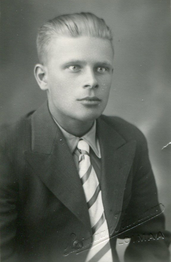WWII serviceman executed for "cowardice"
- Peter
- Jul 7, 2020
- 3 min read
On 31 January 1945, Private Eddie Slovik, the only American serviceman to be executed during WWII, died after having been court-martialed for desertion.
Although Slovik (service number 36896415) had originally been classified 4-F (unfit for service) as a result of his prison record, he was drafted into the U.S. Army after the ongoing war in Europe demanded more personnel.
Slovik hated guns and being a soldier. In a letter to his wife, Antoinette, he wrote that army life was worse than being in jail. On his way to France, he told a buddy that he didn’t see the point of cleaning his rifle, as he never intended to fire it.
Upon reaching France in August ’45, Slovik was to join Company G of the 109th Infantry Regiment, 28th Infantry Division. This Division, also known as the “Keystone” Division, after its distinct combat service badge, by this time had been nicknamed the Bloody Bucket due to its heavy losses. During their trip, Eddie and one of his friends from basic training, Private John Tankey, were separated from the rest of their group when they had to take cover from an artillery barrage. Slovik would later remember this events as the moment he realized he “wasn’t cut out for combat.”
Like many others, Slovik and Tankey lost contact with their unit. However, they stumbled upon some Canadians with whom they stayed for the time being. In October, the Canadians turned the two men over to the American military police. As replacements were getting lost all the time, neither man was charged.
Shortly after, Slovik and Tankey joined the 28th Division in Belgium. Eddie felt too scared and nervous to fight, and after only one day said he would run away if he was forced into combat. Although he had been told running away would get him court-martialed, Slovik went. Tankey tried to talk him out of it, but Slovik had made up his mind and walked to the rear where he presented his signed confession. An MP (military police) read the note and advised Eddie to tear it up. Eddie refused and was taken to a Lieutenant Colonel. Once again, Eddie was given the chance to destroy the note and told that he would face no further charges if he returned to his unit. Slovik refused once again.
A divisional judge advocate then offered to transfer Eddie to a different unit, so he could start with a clean slate. Convinced that he would merely end up in jail for his actions, Slovik again said no. So many people went AWOL (Away Without Official Leave) or shot themselves in the foot to avoid having to fight, that Eddie felt confident he should take his chances and chose to be court-martialed. He was then charged with desertion.
Slovik’s trial on November 11, 1945, took less than two hours. The prosecutor stated that Slovik had told others of his intention to run away, and Slovik himself chose not to testify at the trial. The sentence was unanimous: death by execution. Slovik was shocked, as he had expected to be dishonorably discharged and sentenced to jail time. (Eddie knew this had been the punishment for other deserters while he was in military prison.)
Eddie wrote a letter of appeal to General Dwight D. Eisenhower, the Supreme Allied Commander, was made. The sentence was upheld, however, as Slovik’s trial coincided with the Battle of the Bulge which was claiming thousands of American casualties. Noting that it was paramount to discourage further desertions, Slovik’s sentence was confirmed on 23 December.
Slovik’s death sentence for desertion was the only one that was actually carried out. Slovik faced a 12-man firing squad near the village of Sainte-Marie-aux-Mines at 10:04 a.m. on 31 January 1945. Eddie was then buried in Row 3, Grave 65 of Plot “E” of Oise-Aisne American Cemetery and Memorial in Fère-en-Tardenois, together with 95 other American soldiers who had been executed for rape and/or murder.
The 109th Regiment was the only unit to announce Slovik’s execution and no civilian or military newspaper wrote about it.
Upon learning of her husband’s death, Antoinette Slovik repeatedly appealed to the U.S. Army to release her husband’s remains. She would do so unsuccessfully until her death in 1979. Two years later, World War II veteran and former Macomb County Commissioner Bernard Calka, continued Antoinette’s work. Finally, in 1987, President Ronald Reagan ordered their return, after which they were exhumed and reburied in Detroit’s Woodmere Cemetery, next to Antoinette.
Sources:




Comments